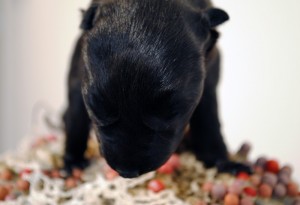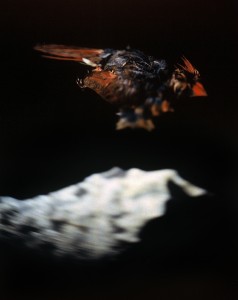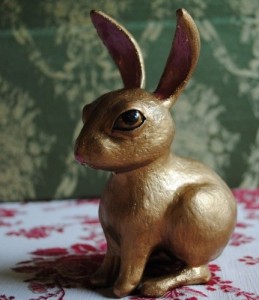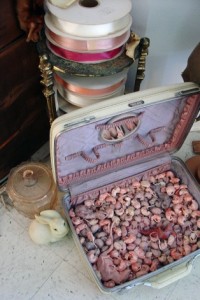Creature Comfort
Creature Comfort (2010-present) is an ongoing, collaborative body of work by Trish Igo and Jill O’Brien, featuring ceramics, taxidermy, preserved specimens, installation art, soft sculpture, mixed media, and found objects.
 All animals (fur, bone, specimens, etc.) were acquired post-mortem. The artists were not directly or indirectly involved in any of the animals’ deaths. All taxidermy was performed solely by the artists unless otherwise indicated.
All animals (fur, bone, specimens, etc.) were acquired post-mortem. The artists were not directly or indirectly involved in any of the animals’ deaths. All taxidermy was performed solely by the artists unless otherwise indicated.
Objects have long served as a profound emotional comfort to us, often creating a range of surrogate relationships. We continually acquire nostalgic items, compensating for what we have lost or never had. By surrounding ourselves with these objects in our homes and daily lives, we are developing an intimacy and a level of comfort that borders a fantasy life. These possessions represent past memories, our personal histories, and reflect the events in life that shaped our aesthetic.
Domestic objects also indicate an idealism; the things we want and want to be. In our private environments, seemingly mundane trinkets and miscellany become trophies and talismans, validating our self image by reflecting our ideal pasts and futures. In similar fashion, we have nurtured a ‘collection’ of pets as they have wandered into our lives, needing care and comfort. As we became more invested in these animals, every stray began to simulate the same potential emotional burden. An overwhelming anxiety pervaded each incident of finding an abandoned animal. This ever-present responsibility created a compulsion to care for the remains of the dead animals we came across as well. Making art allows us to keep an animal preserved, conjointly caring for a neglected animal, elevating a moment, and adding to our domestic imaginarium.
Animal philosophies are rife with contradictions brought about by our childhood idolatry of animals and our societal use and slaughter of them. Commixing these extremes, we create a dreamlike exposé of our haunted relationships to animals. We compose vignettes using objects we covet in order to construct situations that provoke reflection on the subjective and selective ways that people view these creatures. By intertwining our escalating domestic fetishes and increasing beastly burdens, we collect nests for them to dwell, treasuring these animals in a way that assuages us and inspires empathy from the viewer. — Trish Igo and Jill O’Brien
Creature Comfort Images ___________________________________________________________________________________________________________________________________
Crowd of Drifters
Crowd of Drifters: Photographs and Collections (2004-2011) is a collaborative body of work by Trish Igo and Jill O’Brien, featuring large and small scale chromogenic prints (from large format film), preserved specimens, and installation and process art.
 “An animal cannot, so far as we know, transcend its suffering. A helpless elephant hunted by sharpshooters waiting by the water hole, a deer fleeing the hunter or dying on a highway, a pig or lamb or calf trapped amid the bedlam—they cannot draw meaning from their hardship, or find refuge in God, or pray for deliverance. That still leaves the enduring of it, the deprivation and fear and panic and loneliness. We know those feelings too.” [1]
“An animal cannot, so far as we know, transcend its suffering. A helpless elephant hunted by sharpshooters waiting by the water hole, a deer fleeing the hunter or dying on a highway, a pig or lamb or calf trapped amid the bedlam—they cannot draw meaning from their hardship, or find refuge in God, or pray for deliverance. That still leaves the enduring of it, the deprivation and fear and panic and loneliness. We know those feelings too.” [1]
Animals are ideal victims of human violence. In all interactions between animals and our society they are victimized, sometimes intentionally and more often, indiscriminately. Their complete helplessness and inability to ask, complain, or beg for consideration underscores their need for our mercy. Our superiority in reason and industry charges us with moral compassion and responsibility for their quality of life. We believe it may be our awareness of this burden that has instilled our drive to produce art. Because pets were present throughout our childhoods, we have experienced the cycle of love, attachment, and loss and have come to design our lives around this painful knowledge. Animals are the most common experience of death in our lives and therefore become a powerful symbol for our futility in protecting those we love from harm, as well as dealing with our own mortality. These animals—pets, strays, orphans, injured or dying wildlife, and wildings killed by man’s invasion all serve as horrid reminders of the complete loss every living thing will eventually suffer. Despite the inevitable outcome, we continue to adopt and care for animals. With every animal we bring into our homes, we multiply our responsibilities and anxieties about them, and subconsciously about death. The subjugation of animals by mankind is therefore the most threatening emotional burden in our lives.
Just as we adopt animals we consider abused and unwanted, we adopt the dead animals that mankind has struck down and forgotten. It is the emotional distance between ourselves and these animals we never knew in life that makes our attraction to their physicality of death an easier one to explore. We collect the animals, name them, photograph them, prepare them for resting, and keep a physical part of them with us for remembrance. We have created our own methods of ritual that serve as respect towards the animal and as comfort to ourselves. –Trish Igo and Jill O’Brien [1] Scully, Matthew. Dominion. St. Martin’s Griffin: New York, 2002.
___________________________________________________________________________________________________________________________________
Natal Homing
Natal Homing: Nostalgia and Dream Objects in the Domestic (2009-present) is a body of work by Trish Igo featuring ceramic sculpture and hand-crafted objects displayed in tableaux.
natal homing [neyt-l hoh-ming], is the observable behavior of an animal when it returns to the place where it was born.
Our early memories guide our lives and define our identities. Like an animal may imprint its birthplace to later return, we eventually try to return to our past and become the things we admired in our parents and ancestors. By yielding to our nostalgic inclinations, we define our futures with an idealized past.
The objects we surro und ourselves with in our homes and daily lives can reveal our past and our promise. These possessions represent past memories, our personal histories, and reflect the events in life that shaped our aesthetic. Domestic objects also indicate an idealism; the things we want and want to be. In our private environments, seemingly mundane trinkets and miscellany become trophies and talismans, validating our self image by reflecting back our ideal pasts and futures. In this way, it becomes irrelevant if these pasts and futures are authentic.
und ourselves with in our homes and daily lives can reveal our past and our promise. These possessions represent past memories, our personal histories, and reflect the events in life that shaped our aesthetic. Domestic objects also indicate an idealism; the things we want and want to be. In our private environments, seemingly mundane trinkets and miscellany become trophies and talismans, validating our self image by reflecting back our ideal pasts and futures. In this way, it becomes irrelevant if these pasts and futures are authentic.
My last grandparent recently passed away and I feel a whole generation of memories slipping away. There are never enough pictures or mementos to keep the memories close and true. I have dimming recollections of my grandparents and near ancestors, of their homes, the skills they knew, the objects they collected and incidentals they used. I try desperately to retain the simplest images; the most random set of things can embody the entire existence of a person and a time.
Objects weighted with memory are made fetishes. I think of how particular belongings in their houses held an eerie fascination with me as a child. Little figurines, half-finished doilies, wigs and jars of perfume and makeup, bronze quails, porcelain boxes with overwhelming scents, tools in leather pouches; simple things once seemed so surreal that they can now only be accurately represented in dreams.
I collect and make objects to reconnect to my past. They may not have any resemblance to things my grandparents or recent ancestors actually owned, but they make me feel connected to them nevertheless. In this body of work, I am creating the ‘dream objects’ that my ancestors have ‘passed down’ to me so that I will remember them, the lives they lived, the crafts they knew, and the ideals they saw in their futures and in me. –Trish Igo
___________________________________________________________________________________________________________________________________
Pet Dreams
Pet Dreams: a collection of objects and experiences (2006) is a collaborative body of work by Trish Igo and Jill O’Brien illustrating our similar nightmares with a set-like installations that featured ceramic and robotic sculptures, sounds, mixed media, and found objects.
“…I kept venturing back further, becoming more scared and sick as I thought about my old pets I somehow had forgotten. All my animals were in this one room on several tables. Glass and plastic cages had fused themselves together, and plenty had plastic tunnels filled with water, debris, and pieces of hamsters that learned to live independently of an entire animal. Some lived in water; some were just buried in dry heaps of bedding and fur. Some reproduced in abominable ways—some were barely alive. They were abandoned by me and suffering at my hand…”
–artist 1
“…My shelves are stuffed with nostalgic objects and toys and feelings from childhood. All the furniture is the yellow and gold girl-set and my blue toy chest is there and full of wonderful possessions. My ferrets are running around, happily and mischievously investigating these stacks of socks and toys…I search the bedroom and notice that it turns into a haphazard lab with tanks and aquariums and buckets all clumped together with tunnels and filters. I see charlie. Her hair is gone and her skin is translucent and mucousy. I see sammy in a filthy tank, laying in an inch of water. He too is bloated and hairless, and as I look in, horrified, his red eyes roll toward me accusingly and full of hate…”
–artist 2
This in stallation is based on the pet-anxiety dreams that we both share. In discussing and relating our dreams to each other, we discovered that our pet dreams had a myriad of obscure details in common. We began to investigate our lifestyles and our pasts for clues to their origins and meanings. The dreams all seem to revolve around the burden that our pets have on us emotionally, our fears of neglecting them, and the guilt that we have from feeling so overwhelmed by our responsibilities to them. In the dreams, these emotions are delivered by horrible imagery of abuse or neglect in bizarrely nostalgic settings and past places.
stallation is based on the pet-anxiety dreams that we both share. In discussing and relating our dreams to each other, we discovered that our pet dreams had a myriad of obscure details in common. We began to investigate our lifestyles and our pasts for clues to their origins and meanings. The dreams all seem to revolve around the burden that our pets have on us emotionally, our fears of neglecting them, and the guilt that we have from feeling so overwhelmed by our responsibilities to them. In the dreams, these emotions are delivered by horrible imagery of abuse or neglect in bizarrely nostalgic settings and past places.
We believe that these dreams we share are not only inspired by the fact that we own and adopt pets as we have over our life, but also by the fact that we are both collectors and have a distinct need to collect, categorize, and organize things that we find and own. We view our mundane findings as relics and our collections as rituals. We obtain, keep, treasure, and are simultaneously plagued by the endless stacks, piles and shelves of objects and oddities that we can’t seem to let go. Caring for and living with the objects and pets we are compelled to keep can instigate an overwhelming cycle of anxiety. We believe this sense of anxiety is most powerful when it is presented in our dreams.
Our work aims to replicate these dreams. Each part of the installation uses ceramics, plastics, and mechanized media amidst found objects and furniture to communicate a specific feeling or memory that we have experienced in dreams of animals. We arrange the show in a narrative format and create transitions to show the structure of dreams, moving from one idea or scene into another. The store, disintegrating from a perfect merchandise utopia into an absurd and horrific conglomeration of objects, false animals, and real specimens is meant to illustrate that particular feeling in a dream or nightmare when things begin to feel horribly wrong. The uncanny we experience in dreams is so unsettling because it best simulates those moments in our routine life where a surreal shock in the everyday reminds us subconsciously of our impending mortality. The pet dreams show us that regardless of how well we tend to our responsibilities to our loved ones, we can never prevent their deaths, or our own. –Trish Igo and Jill O’Brien